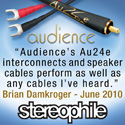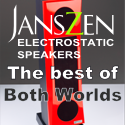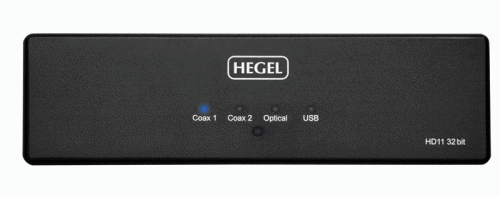|
|
You are reading the older HTML site
Positive Feedback ISSUE 63
hegel HD11 DAC as reviewed by Will Wright
Back at the dawn of digital audio, my first decent player was a Magnavox CDB650, an inexpensive but reasonably good sounding player and one of the most popular for hot rodding. My unit was no exception and I modified it and experimented with it until it died as a result, no doubt. This set me on a quest for its replacement. At that time, the hot setup was separates, i.e. a transport and DAC rather than an all in one player. I ended up with the Theta Data transport and Gen Va DAC, both of which I loved. Digital audio was changing fast, along with the current wisdom of what constituted the best approach. So, by the time I was ready to upgrade from my Theta gear, separates were no longer in vogue and all-in-one players were back in the spotlight. My next purchase was the Esoteric DV50, a universal player which was the first digital product to garner an A+ rating in Stereophile's recommended components listing. The DV50 was, in essence, a DVD player, albeit one that would play DVD-A, SACD, CD and, of course DVD-V. It was built like a tank and had a price tag to match. It wasn't a bad player for movies either, as long as you were willing to use the analog RGB outputs. It predated Blu-ray as well as HDMI. An upgrade became available for the DV50 that would add higher quality video performance and digital video outputs, among other things; but, given the $1000 price tag and the fact that it didn't play Blu-ray, it didn't strike me as a good use of $1K. Today, with few exceptions, so called universal players, including those from Esoteric, all seem to forgo DVD-A, counting it as a dead format. For that reason, I've held on to this player for a while and will likely keep it around for a while longer, as I have a lot of DVD-As. Time marches on rather quickly in the field of digital audio and, wouldn't you know, DACs have come back into popularity, many of which are tagged with the USB DAC moniker. I decided that it might be interesting to see at what price point some of these new products could compete with the sound quality I was getting from the DV50, reasoning that I could still use the Esoteric player as a transport and also expand my horizons in the world of digital servers for audio use. I already had a sizeable digital library on my 1Tb NAS drive. One of the first of these DACs to come my way is the Hegel HD11. The Company, the Philosophy, the Technology It would be no surprise if you have heard little or nothing about Hegel, a Norwegian company popular in Europe but new to our shores. The company offers a variety of products including not only three DACs but CD players, integrated amps, preamps and power amps. Hegel's stated philosophy is to create innovative products that give a better value for money than anything else on the market; and the core of their technology appears to be the patented (US patent 6275104) Hegel SoundEngine audio modules, which incorporate what the company refers to as dynamic error cancelling. The adaptive mode USB technology used in the HD11 DAC simulates a computer sound card and is purported to reduce noise artifacts simply by moving this function to the outside of the computer. Hegel's unique implementation is also said to contribute to lower distortion and higher dynamics. I was originally interested in the HD20, Hegel's top of the line DAC, but was intrigued by the 32bit technology of the HD 11, successor to the well regarded HD10, and decided to give it a try instead. Though I could find no mention of it on the Hegel website, the chip technology in the HD11 appears to be a 32bit AKM DAC. First Impressions and Specifications If you've shipped many electronic devices to and from your residence, you will have quickly learned the value of proper shipping containers. Hegel appears to have learned this lesson as well as the HD11 came in a sturdy double boxed shipping container. Pulling the unit from its packaging, I was immediately impressed by the solid, no nonsense construction and simple, understated good looks. This DAC had heft and solidity for its size, lending to the impression of a serious and professional product. No plastic here! The chassis exterior is a heavy gauge bent metal top and quarter inch aluminum front panel. There is ventilation on the bottom and back and there are three rounded rubber feet. The front panel display consists of a power LED and four green LEDs labeled in white lettering to indicate the chosen input. The back has both RCA single ended and XLR balanced stereo analog outputs. Digital inputs include two S/PDIF RCA, one Toslink, and one USB. The remainder of the rear panel contains the fuse holder, IEC power connector, and On/Off toggle switch. A small, almost key fob sized remote is included, which works with numerous other Hegel products. The only remote functions pertinent to the HD11 are the input selector buttons… which are only accomplished via the remote, so don't lose it or step on it. The included user's guide specifies all HD11 inputs are 24/192 capable except USB, which is 24/96. Output signal level is 2.5V RMS, noise floor is -140dB and typical distortion is less than 0.0007%. The power supply features a toroidal transformer and 30,000microFarads of capacitance. The analog filter is linear phase. Recommended break in is 100 hours. Overall, one has the impression of a solidly built product without frills and a sense that the design emphasis is performance. Setup I placed the HD11 on top of my Esoteric DV50 to allow it to take advantage of the Critical Mass Systems isolation platform on which the DV50 sits. All cabling was Soundstring Gen II, identical to that connecting the DV50 to the rest of the system. As recommend by Hegel, I used the Coax 1 input to connect the HD11 to the digital output of the Esoteric player. Also as recommended, I used the HD11s balanced outputs. I connected the USB and Toslink inputs to a dedicated computer based on a 6 core AMD processor with 8 Gigs of memory. The Toslink connection was to the built in sound from the computer's motherboard. Initially, all sources were fed to my Alchemist Tim deParavicini Signature Preamp. Later, I swapped in the JE Audio VL 10.1 vacuum tube line stage amplifier, which will be the subject of my next review. All other equipment was as noted in my writer's profile. Because of the long recommended break in period, I left the HD11 on continuously during the review period, which lasted several months. I let the unit run for about a week before I started my evaluation and monitored its performance for changes as time went by. Listening Everything I had seen and read regarding the HD11 left me with high expectations for this $1200 DAC. My first critical listening was done using the Esoteric DV50 as a transport and the Coax 1 input that Hegel recommends. Please note that Hegel doesn't specify, either in the user's guide or on their website, what makes Coax 1 better than the other S/PDIF inputs. To quote the guide, "The Coxial 1 input on the HD11 has even better sound quality compared to the other digital inputs. Therefore we recommend that you connect your favorite source to this input." If you read back over my specifications section above, you'll note that Hegel describes their technology only in rather vague terms. They really don't tell you much of anything except that they think they are doing a really good job. That's fine, except that it doesn't give you much to go on. Granted, not everyone is a techy type and perhaps they deem this sort of info of little interest to the majority of their customers. To start, I tried a couple of selections from the recent Beatles box set CD remasters. I also listened to selections from the XRCD of the Duke Ellington Quartet titled Duke's Big 4. Regardless of the selections, and there were many, the musical perspective via the DV50 as transport to the HD11 Coax 1 input was consistently flat and undynamic; exactly the opposite of what I was expecting. Regardless of the type of music, the sound was essentially uninvolving and lifeless compared to the DV50 alone. I heard this and, initially thought I'd simply not reached the break in point where things would open up. So I let the device cook for another week or two and tried again. Unfortunately, I was never able to achieve acceptable sound with this combination. The frequency balance was even and extended from low to high with no obvious hot spots or dropouts, but I could not squeeze any life from this setup. The musical content was simply rendered in a way that made me want to turn it off. Could it be that the DV50 just isn't a very good transport? To test this, I connected the DV50 to other DACs and got consistently good results. The HD11 is the least expensive DAC I've used in my system and I began wondering if it was necessary to go more upscale than this to achieve really good results. I was really scratching my head over this and was very unhappy with the prospect of reporting this to our readers. It then occurred to me to try something different. Instead of the DV50 as a transport, I connected the HD11 Coax 1 input to my Alesis Masterlink CD recorder's digital output. I'd like to report that this changed things dramatically but the truth is that while it was a definite improvement, it still didn't bring the performance levels up to match the DV50 alone. Still, it did push the performance up to the point that the music was listenable but still somewhat squashed, dynamically speaking. As an example, I played a CD of Michael Jackson's 1979 release Off The Wall. I know this is not an audiophile approved disc but anyone familiar with Jackson's work knows that it is typified by punchy bass and driving rhythms. Using the Masterlink as transport, the only way to really feel that power was to turn the system WAY up. Still, I was definitely starting to get my motor running. Other musical selections through this input rendered similar results. Playing music files from my NAS drive via the computer motherboard's built in sound, connected using the third S/PDIF Toslink input on the HD11 did not change my impression. I'm actually rather skeptical of the USB interface as a musical conduit. I've always viewed it as a convenience connection, rather like MP3 is a convenient way to pack a lot in a small space and not a path to high quality sound, so I wasn't sure what to expect. As advertised the HD11 automatically installed itself on the computer when a USB connection was established. Also, as mentioned on Hegel's website but, surprisingly, not in the included user's guide, a rather unique functionality in the HD11 is the ability to remotely control computers that are connected to the USB port. If you start a play list, you can use the HD11's remote control to start/pause and browse around in your play list. As examples of sound quality, I'll discuss two different selections and contrast what I heard. First up, I listened to selections from The Life and Music of Richard Thompson, a five disc set ripped to my NAS from CD. I must say that, given my experience with the HD11 up to this point, I was shocked at the sound quality I achieved via USB. Without exception, this was as good as anything I've ever achieved in my system via a USB interface and a night and day difference from what I'd achieved so far from the HD11. The sound was nuanced, dynamic, articulate, and detailed. Soundstaging was spacious and layered. Thompson's vocals and guitar playing drew me right in and held me in an intimate soundscape. The HD11 did not over or under emphasize vocal aspects. Head, throat, and chest sound contributions were well balanced as was the guitar body and string tone. Ambience was also well served. Bass articulation was excellent. Next, I listened to The Best of the Alan Parsons Project. This is a rather flat sounding early digital transfer and I knew this. After listening to what the HD11 did with Richard Thompson, I wanted to see what it revealed with lesser material. If anything, the HD11 revealed even greater contrast between these very different performances than I had heard playing these discs directly via my Esoteric player. It didn't pretty up the sound of the Parsons disc; it told the truth about the recording. Through the USB interface, the Hegel DAC performed at the level I'd been hoping for via all the inputs and finally revealed its pedigree. This encouraged me to explore my digital library and listen to Bob Dylan, Aaron Copland, Antonio Carlos Jobim, and many others. The music I sampled ran from full resolution uncompressed files to low bit rate MP3s, all with excellent results. Conclusions When I first received the Hegel HD11, my initial research took me to the review section of the Hegel website. At that time, there were only three reviews of the HD11, all from European reviewers and only one of those had an English translation. I had been a bit frustrated with the available info on the website as well as the user's guide. In the case of these other reviews, technical discussions with the Hegel designers may have been part of their review process. In my opinion, the type of info gleaned from these interviews would be a welcome contribution to the main body of HD11 website info and would provide useful insight into the nature and quality of Hegel products. At the point of finalizing my own results, I revisited the site and discovered that there were now nine reviews, still all from European sources. The most recent of these, the hi-fi+ review by Alan Sircom, had this tidbit about the nature of the Coax 1 input, "The HD11 32-bit has its own custom re-clocking system instead, as well as a special impedance matching circuit (on COAX 1) to reduce any cable-interface jitter problems in their own right." I speculate that Alan's insights came from a source inside the company. Since a customer evaluating a product such as this is unlikely to have access to technical info from the designers, unless it's included in the commonly available sources, one review approach is to evaluate the product from the typical customer's point of view. Though in this case my review leans more this way, I consider both approaches valid. Since everything appeared to be working and I had not encountered any usage problems there was no reason to suspect that I was not hearing what the company intended. In hindsight, I wonder if I may have had a faulty review sample. Murphy's Law applies here. In fairness to Hegel, I would welcome their comments regarding this review and would be willing to try a second sample and report my findings if the company deems this prudent. Short of that, I can only say that the S/PDIF inputs fell short of my expectations and the excellent performance available via USB interface. Will Wright
HD11
Hegel
|









